Central or central heating of residential buildings
In order to understand what central heating is (more often, the term centralized is used to define it), we need to understand how this all works in the complex. The fact is that the method of supplying coolant to radiators can be very different from each other.
Therefore, in such cases, your approach to the same installation or replacement of heating devices will also change. We will understand the difference between single-loop and dual-circuit systems, find out which radiators are better to use and watch a video clip fixing the theme.

Centralized systems
Note. The main difference that determines the central heating systems is their functioning from a common boiler house or CHP, while autonomous heating is carried out using a home boiler room. For the average user, this, in fact, does not matter, but when it comes to maintenance or overhaul, then this has to be paid attention to.
Independent and dependent system
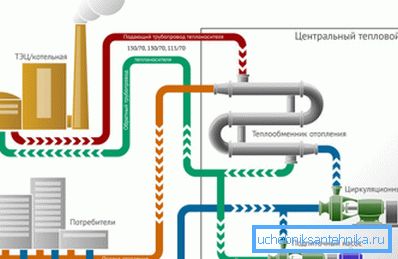
- If the system is independent, then the powerful central heating boilers do not supply the coolant directly to the contours of residential or non-residential premises, but first to heat points, where the redistribution takes place. That is, hot water from a CHP plant or a powerful boiler house enters such TPs through large-diameter pipes, then, depending on the needs of a group of buildings, a house, or an entrance, it is distributed over the power of the heating medium. These TPs are equipped with circulation pumps, which, if necessary, can increase the flow rate (for example, for a nine-floor building).
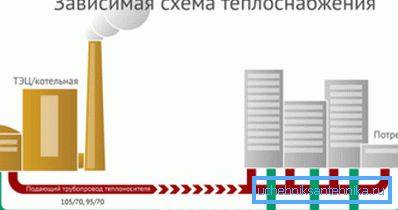
- In cases where the project is made according to a dependent scheme, the central heating system supplies hot water directly to the radiator circuits of each residential or non-residential premises, without prior distribution of the power flow.. It should be noted that the circulation pump in its work does not affect the temperature of the coolant - it creates additional pressure required for the upper floors of apartment buildings.
Single circuit system
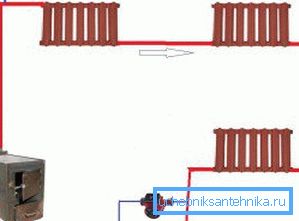
This scheme is used quite often, but there are significant drawbacks of central heating (one-pipe) due to large heat losses during transportation of fluid. Usually they are compensated by increased pressure in the system, but, nevertheless, very often you can hear complaints from residents living in such houses.

The essence of the operation of such a scheme is as follows: hot liquid is supplied through a pipe, to which radiators for central heating are connected by means of the inlet and outlet connections. That is, the heated water during circulation through the ribs of the device cools down and again enters the central distribution pipe.
This means that the temperature of the liquid for the next battery will be lower, and so on. Without losses, usually no more than three or four, maybe five devices can function.
But in apartment buildings there are problems with such a large number of radiators per supply pipe, and the reason often lies in poor insulation of the premises. The residents, instead of insulating the windows and doors, and possibly the walls, begin to increase the number of sections on the radiators with their own hands - in some cases their number exceeds 20 pieces!
Now - simple arithmetic - if in the riser of a five-story building there used to be 5 batteries of 10 sections each, under which the design capacity was calculated, now they are twice as large - usually only the first two floors receive enough heat (upper or lower), depending on where the filing starts).

In order to reduce heat loss in such systems, bypasses are often installed in front of radiators, as you see in the photo above, only taps on them, as a rule, are not provided. It turns out that part of the hot stream can circulate with minimal heat loss, if it does not fall entirely into the battery section.
But a tap inserted there (into the bypass) in the closed position allows the water to be redirected through the radiator, that is, with maximum temperature loss.
Dual circuit
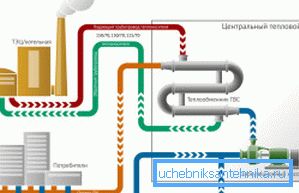
Dual-open or closed-type heating system allows the flow of fluid in a continuous temperature regime for all floors, although the price of materials and installation here is somewhat higher than that of a single-circuit. Funds are spent on pipes for central heating.
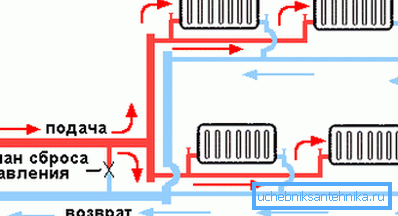
In a dual-circuit system, central heating radiators are independent of each other, since they return the cooled liquid to the return pipe and this coolant flows back to the heating point (CHP or boiler room) without affecting the temperature of other batteries. Hot water is also supplied through a single pipe.
Note. Considering the fact that there is high pressure in centralized systems, cast iron radiators are provided for under the project. But if you want to improve the interior design, the instruction allows you to replace them with steel or bimetal radiators, which also hold pressure well.
Conclusion
So, in the direct (generally accepted) understanding, centralized or central heating is a system that operates from a CHP plant or a common boiler house. But autonomous heating in a private house can also be considered as such, if we consider it from each room, since all of them are powered from a common point.